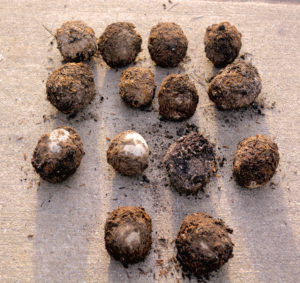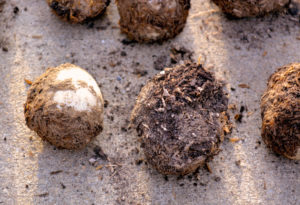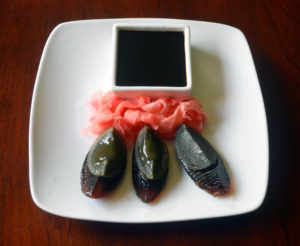
We harvested the 1000-year eggs and are finally getting around to preparing and eating some of the crop. The color is right, and a few of them have the pine-patterning that their Chinese name suggests on their dark, amber-colored flesh. They taste good, but are MUCH milder than some of the Pidan I’ve had in China. They are also missing the strong ammonia-like scent that accompanies some commercial century eggs I’ve had.
For those of you who are just tuning in to this culinary adventure of mine, check out this post to see how the eggs were transformed. This is how they looked the morning I harvested them.
They didn’t look particularly appetizing at this stage. But swim on, I told myself, the results will be worth it. I cleaned them using a bit of water and some elbow grease, but I had to be very gentle so as to not crack the shells. The shells are rather delicate by the end of the process, because they have been permeated by the chemical brew of tea, salt, ash and lime.

Some of the shells had a bluish tinge to them and some of them were a mottled off-white as shown above. When the first crack revealed a solid amber flesh, I was overjoyed! All of the eggs were transformed, but some were a bit runny in their forest-green centers. After cleaning, I let them dry completely and then placed them in the refrigerator until I could prepare them. I was very pleased with the results.

This is one of the most common ways to serve them – simply as a snack, or appetizer, or part of a large collection of dishes that might also include pickled diakon radish and pickled carrots, some sliced abalone or some and barbequed pork. The presentation pictured here is most like the Cantonese way of eating the eggs – simply wrapped in slices of pickled ginger. Elsewhere around China and Taiwan people enjoy them with tofu or as a flavoring to omelets made with fresh eggs.
My eggs were creamy but still a bit sharp, sort of like the sharpness of a very pungent cheese. So don’t blindly believe all of the macho videos out there that show nervous boys choking them down. The flavor is strong, but enjoyable. In the preparation I made, the ginger works nicely to modulate the flavor of the eggs, and the soy dipping sauce is completely optional in my personal opinion.
Other ways to prepare them that I am set to explore soon include using them to flavor a congee (rice porridge) along with bits of pork (皮蛋瘦肉粥), and perhaps one of the recipes with chilled tofu – so stay tuned for more 1000-year eggs. (All words and photos by Laura Kelley.)

In HKG, besides having them in shredded or diced roast pork Juk, Congee, the most popular way, by the way. Was to just slice the eggs in wedges and sprinkle sugar on them as a side dish for lunch or dinner.
Hi Charles:
Thanks for the info – that’s very interesting! Were they tasty this way?
Laura